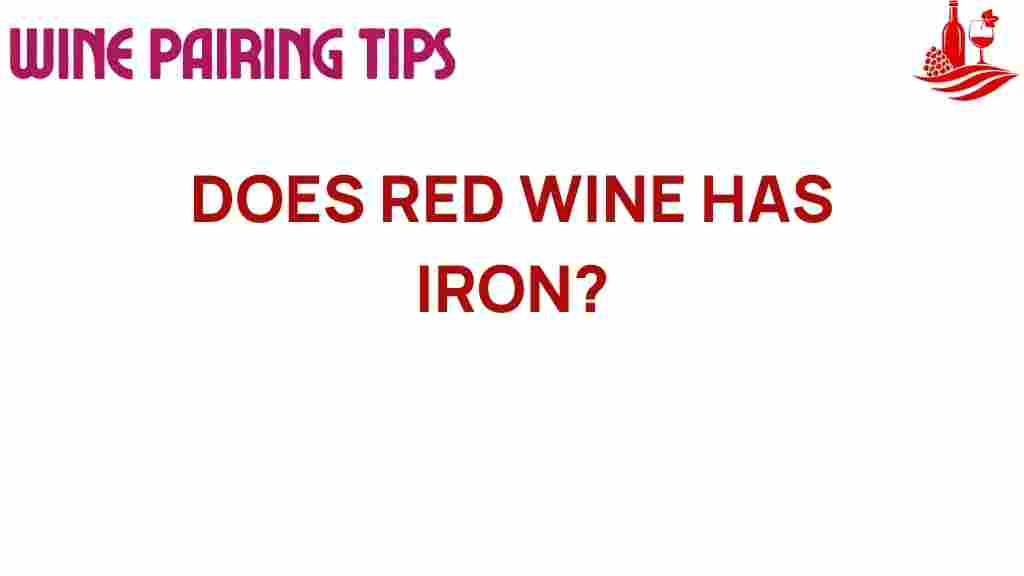Unearthing the Truth: Does Red Wine Really Contain Iron?
When it comes to red wine, many enthusiasts often ponder not just its rich flavor and aroma but also its nutritional content. Among the various myths surrounding wine, one that stands out is the question of whether red wine really contains iron. In this article, we will explore the iron content in red wine, delve into its health benefits, and bust some common myths surrounding wine’s nutritional profile.
The Nutritional Profile of Red Wine
Red wine is not only a delightful beverage but also a source of various nutrients. Understanding its nutritional profile can help us appreciate it better. The main components of red wine include:
- Antioxidants: Red wine is rich in antioxidants, particularly resveratrol and flavonoids, which are known for their health benefits.
- Vitamins: It contains small amounts of vitamins, including B vitamins like riboflavin and niacin.
- Minerals: Red wine also includes minerals like potassium and magnesium, but the question remains about its iron content.
Red Wine and Iron Content
Now, let’s address the core of the discussion: the iron content in red wine. While it’s true that red wine contains trace amounts of iron, the levels are relatively low compared to other dietary sources of iron. Here’s a breakdown:
- Typical Iron Content: On average, a 5-ounce glass of red wine contains about 0.1 mg of iron.
- Dietary Recommendations: The daily recommended intake of iron varies by age and sex, but for adult men, it’s about 8 mg, and for adult women, it can range from 18 mg to 27 mg during pregnancy.
- Comparison with Other Sources: Foods like red meat, legumes, and fortified cereals provide significantly higher iron content.
Health Benefits of Red Wine
Despite its low iron content, red wine offers several health benefits, largely attributed to its rich array of antioxidants and other nutrients:
- Heart Health: Moderate consumption of red wine is linked to improved heart health due to its ability to increase good cholesterol (HDL) and reduce bad cholesterol (LDL).
- Anti-Inflammatory Properties: The antioxidants found in red wine can help reduce inflammation and lower the risk of chronic diseases.
- Improved Longevity: Some studies suggest that the resveratrol in red wine may contribute to a longer lifespan by protecting against age-related diseases.
Myth-Busting: Red Wine and Iron
There are several myths about red wine that need to be debunked. Here are some common misconceptions:
- Myth 1: Red wine is a primary source of iron.
Fact: As discussed, the iron content in red wine is minimal compared to other sources. - Myth 2: Drinking red wine can prevent anemia.
Fact: While moderate red wine consumption may contribute to overall health, it should not be relied upon for iron intake. - Myth 3: All red wines have the same nutritional profile.
Fact: Nutritional content can vary significantly between different types of red wine.
Dietary Sources of Iron
To maintain healthy iron levels, it’s essential to incorporate various dietary sources of iron into your diet. Here are some excellent sources:
- Red Meat: Beef and lamb are among the richest sources of heme iron.
- Poultry: Chicken and turkey provide good amounts of iron.
- Fish: Certain fish, like tuna and salmon, are also good sources.
- Legumes: Beans, lentils, and chickpeas are excellent plant-based sources of non-heme iron.
- Fortified Foods: Many cereals and grains are fortified with iron, making them valuable dietary sources.
Step-by-Step: How to Enjoy Red Wine Healthily
To maximize the health benefits of red wine while being mindful of its iron content, follow these steps:
- Choose Quality: Select high-quality red wines known for their rich antioxidant content.
- Moderate Consumption: Stick to moderate consumption—generally defined as one glass per day for women and up to two glasses for men.
- Pair Wisely: Enjoy red wine with iron-rich foods to enhance overall iron absorption.
- Stay Informed: Keep up with research on wine and health to make informed decisions.
Troubleshooting Tips for Wine Enthusiasts
If you’re looking to enjoy red wine while managing your iron intake or overall health, consider the following tips:
- Consult a Professional: If you have specific health concerns, consult with a healthcare provider or nutritionist.
- Balance Your Diet: Ensure your diet includes a variety of iron-rich foods alongside your wine consumption.
- Stay Hydrated: Drink plenty of water, especially if consuming alcohol, to maintain hydration.
Interesting Wine Facts
Here are some intriguing wine facts to enhance your knowledge:
- Oldest Wine: The oldest known wine bottle dates back to 325 AD and is displayed in a museum in Germany.
- Wine and Health: Some studies have shown that moderate wine drinkers may have a lower risk of heart disease compared to non-drinkers.
- Varietal Differences: Different grape varieties can significantly affect the nutritional content and health benefits of wine.
Conclusion
In conclusion, while red wine does contain trace amounts of iron, it is not a significant source compared to other dietary options. However, its rich array of antioxidants and potential health benefits make it a worthy addition to a balanced lifestyle when consumed in moderation. By busting myths and focusing on nutritional facts, we can enjoy red wine sensibly and healthily.
For more detailed information on wine and its benefits, you can check out this resource. If you’re interested in exploring the world of wine further, don’t hesitate to visit this informative site for wine facts and tips.
This article is in the category Tasting and created by Wine Pairing Tips Team
